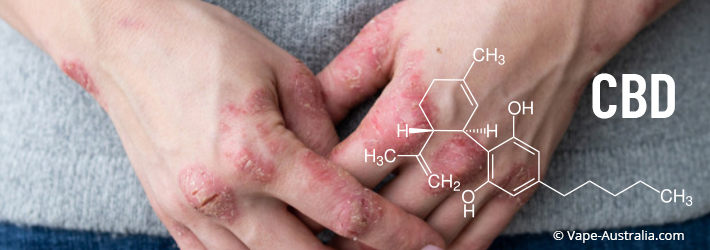
What Is Psoriasis?
Psoriasis is a disease where red, scaly patches appear on the skin. There are several different types of psoriasis, but 90% of people with it have something called plaque psoriasis. This is where skin cells grow too fast and create a build-up of dead, patchy skin.
This build-up of the skin can be mild but it can also range up to covering 5% of your body. 5% doesn’t sound too impressive, but it’s actually a lot of surface area. Not only is it unsightly, but it’s also painful and can create a whole host of other issues.
How CBD Works?
Your body has something called an endocannabinoid system. This endocannabinoid system is connected to all kinds of things, including pain, inflammation, mood, etc. Your body creates cannabinoids that attach to your endocannabinoid receptors that send signals that influence these things.
Science doesn’t understand the full implications of this yet, and how it all connects, but they do understand that you have these receptors all of your body, including in your skin. When you take CBD internally or apply it on the skin in the form of a topical, it triggers your body to release its own cannabinoids.
This can create a variety of effects and results. The aim of researching and understanding CBD is still fairly new in the scientific community and there are aren’t enough studies on humans to understand the full implications of this. However, some of what they’ve learned is promising.
How Does CBD Affect Psoriasis?
A study was done in 2007 on the effects of CBD and psoriasis. At the end of the study, they concluded that the results indicated a potential use for CBD and psoriasis, as those who used cannabinoids slowed the proliferation process (creation of new skin).
Not only that, but there’s been research to indicate that CBD can also help your body regulate the amount of sebum (oil) that’s being produced. While this is exciting for those of you who create too much sebum and end up with acne, this is also promising for someone with psoriasis and dry skin.
As mentioned previously, psoriasis can also cause some measure of pain. CBD has shown to inhibit pain to some degree, and if you’re applying CBD to areas with pain, then you could experience some pain relief. Most who use CBD for psoriasis do so for the other benefits (not pain relief) but it is a possibility.
How to Choose CBD Products for Psoriasis
Since it is a skin condition and you have endocannabinoid receptors in your skin, it is recommended to use CBD topically. This targets the area you’re hoping to see results in. CBD topicals come in a variety of shapes and sizes, and you can check out our guide on how to choose them.
Mostly, though, you want to look for something moisturizing and hydrating. You want something that’s packed with other helpful ingredients so that you get the most out of the treatment as possible. Balms and creams are typically thicker, so you might enjoy those better than a lotion. They’ll take a little bit longer to absorb and will sink into the skin.
Ensure that you’re using a product with a high amount of CBD in it. Products with 300mg to every 2oz is a good measuring point. You don’t want anything less. If there’s more than that, be aware that the product has a higher concentration (which might be a good thing for you!).
Whenever you use a CBD topical, always make sure to leave it on for at least 10 minutes to ensure maximum absorption. So, don’t engage in any activities that could rub it off like swimming, sweating, or showering.
